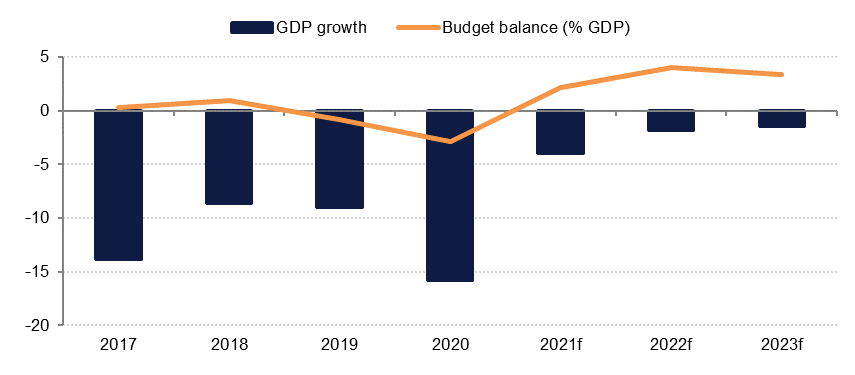
Oman’s budget deficit narrowed sharply to just OMR 1.22bn (-4.0% GDP) in 2021, according to preliminary estimates, compared to the OMR 4.4bn (-15.8% GDP) shortfall in 2020. The main driver was the improvement in oil and gas revenues last year. Oil prices and production increased in 2021, while gas revenues jumped 41% y/y on the back of higher LNG export volumes and gas prices.
Expenditure also declined based on preliminary 2021 figures, but still came in 12% higher than planned last year. Some of the lower expenditure was due to methodology changes – hydrocarbon spending has been shifted off-budget to state owned Energy Development Oman (EDO), which now also holds the government’s stake in the country’s main oil company Petroleum Development Oman. EDO will pay royalties, taxes and dividends to the budget and will issue debt to fund its capex going forward.
Oman’s 2022 budget projects a modest widening of the budget deficit to OMR 1.55bn in 2022 (-4.9% of estimated GDP). However, the budget is based on an average oil price forecast of just USD 50/b. We expect Brent oil to average USD 68/b in 2022, and as a result our oil revenue forecast is almost 40% higher than budgeted. Non-oil revenues are also expected to rise this year, with the budget projecting a 20% increase on actual 2021 non-hydrocarbon revenues. Our forecast is for a more modest increase in non-oil income, but we still expect total revenue in 2022 to be 9% higher y/y.
The 2022 budget assumes spending of OMR 12.13bn, similar to actual 2021 spending, while we expect expenditure to come in higher than planned at OMR 12.5bn. Despite our higher expenditure estimate, we expect the budget deficit to narrow to OMR 0.6bn (-1.8% GDP) this year, a better outcome than the government’s own projections which are based on the much more conservative oil price assumptions.
While the headline deficit has narrowed, almost 70% of revenue will come from oil and gas this year, leaving the budget vulnerable to negative oil price shocks in the future. Debt service costs have increased sharply over the last five years, and are set to rise another 20% in 2022. The budget for electricity and other subsidies is higher in 2022 than in 2021, and defence and security still accounts for 25% of total spending although this share has declined from 35% ten years ago.
In late December, ratings agency Fitch upgraded its outlook on Oman’s long-term foreign currency debt rating to ‘stable’ from ‘negative’, citing the improved budget and debt dynamics and the prospect of further reform.
With no new GDP data for 2021, we retain our estimate of 2.2% GDP growth for last year, and expect growth to accelerate to 4.0% in 2022, largely on faster hydrocarbon sector growth. The finance ministry indicated that oil production would rise to over 1mn b/d in 2022, which implies growth of around 5% from average 2021 oil output.
 Source: Haver Analytics, Emirates NBD Research
Source: Haver Analytics, Emirates NBD Research